California
The best water rides in Southern California, ranked by splash factor

Robotic dinosaurs. Mechanical miners. Unpredictable chaos. Our local water rides offer the promise of getting wet with a dash of surprise and excitement.
Home to four world-class theme or amusement parks, the Southland isn’t lacking in inventive ways to get soaked. Some of these rides are exquisitely designed, emphasizing show scenes and story rather than simply pummeling us with water. Others aim to do exactly that.

In L.A., water rules everything around us. Drink up, cool off and dive into our stories about hydrating and recreating in the city.
Getting waterlogged, after all, is part of our history. In 1900, Los Angeles was home to one of the first major American takes on a water ride, Shoot the Chutes at Chutes Park in Historic South-Central. Rising 75 feet, it utilized flat-bottomed boats and a cable to take passengers up an incline.
Today, our water rides are more advanced and just may be among the best in the country. We’ve ridden them all, and did so without ponchos, to grade them based on wetness. Five droplets means you’ll get doused; one droplet is more akin to a light sprinkle.
Missing from this list is Disneyland’s Splash Mountain, which is being refashioned into Tiana’s Bayou Adventure, a “Princess and the Frog”-themed ride that is due to open later this year. We’ll be there when it opens. In the meantime, here’s a ranking of what you can ride now.

(Charles Sykes / Invision / AP)
Pirates of the Caribbean

Disneyland’s 1967 boat ride is a leisurely jaunt through a town in the process of being ransacked by inept (read: mostly drunk) pirates. Yet there are two early drops — one moderate and one relatively small. Depending on the weight of the boat or the height of the water, expect to get lightly splashed. Because this is primarily a slow-moving family attraction, the water can either be an unexpected delight or an intrusion. But with reliably brisk air conditioning and a 15-minute-plus length, chances are you’ll dry off by the ride’s conclusion. More important, you’ll have experienced one of the most vital attractions at Disneyland, as its abstract approach to narrative set the template for the modern theme park ride.
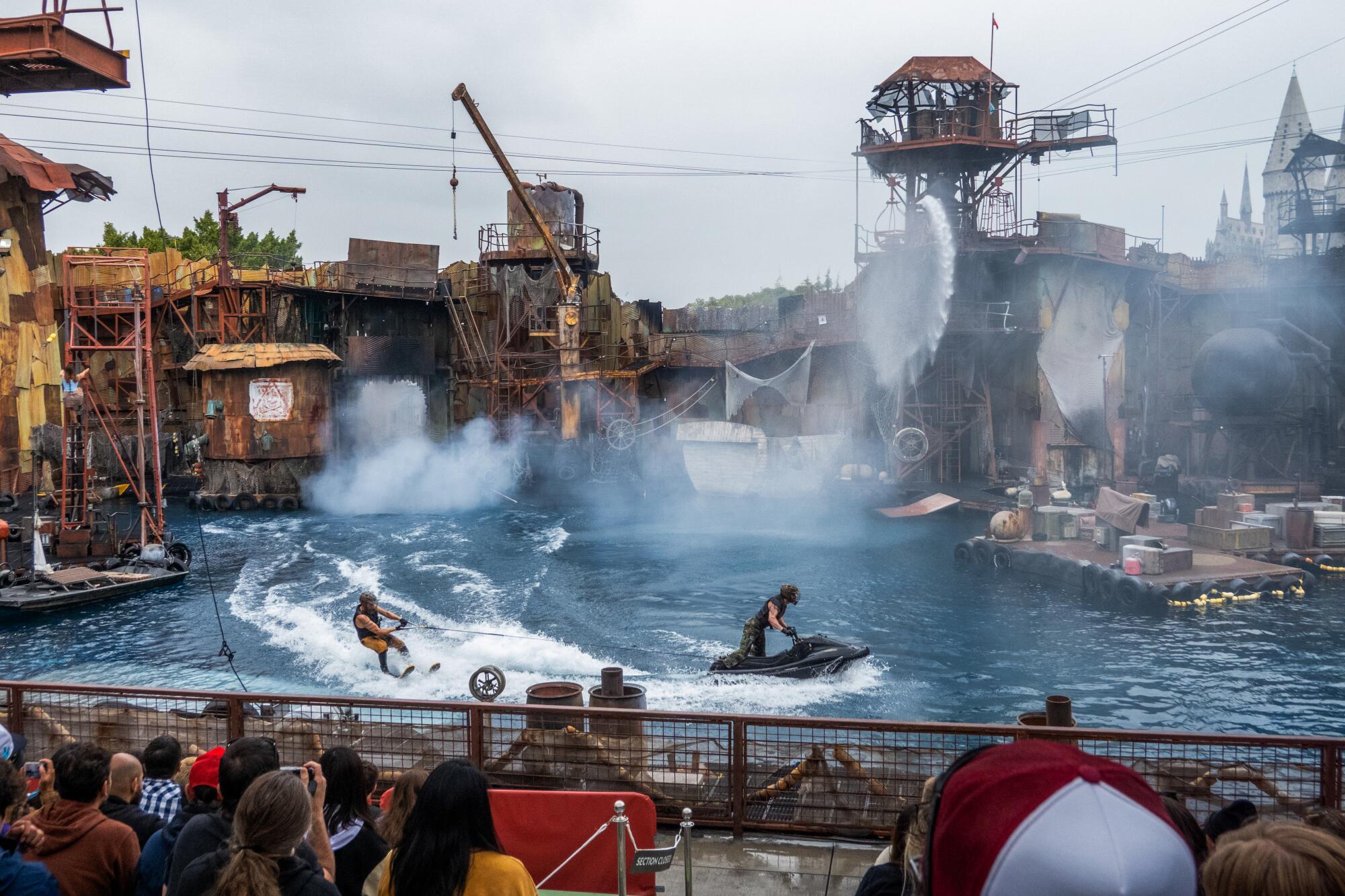
(Myung J. Chun / Los Angeles Times)
Waterworld

OK, perhaps it’s odd to include a theme park show on a list of water rides. But Universal Studios’ stunt-focused spectacle is centered entirely on water, so it made the cut. Additionally, the large arena that houses the show contains a rather large splash zone, meaning anyone sitting in that particular section of the bleachers will get wet. The show is essentially a love letter to action-driven movie illusions, and a real hoot. Some moments never cease to surprise, such as a full-scale seaplane being jettisoned into the pond. And yes, a splash ensues. Those sitting in the wet sector will get sprayed with a decent amount of water, but if that’s not your thing it’s clearly marked and easy to avoid.
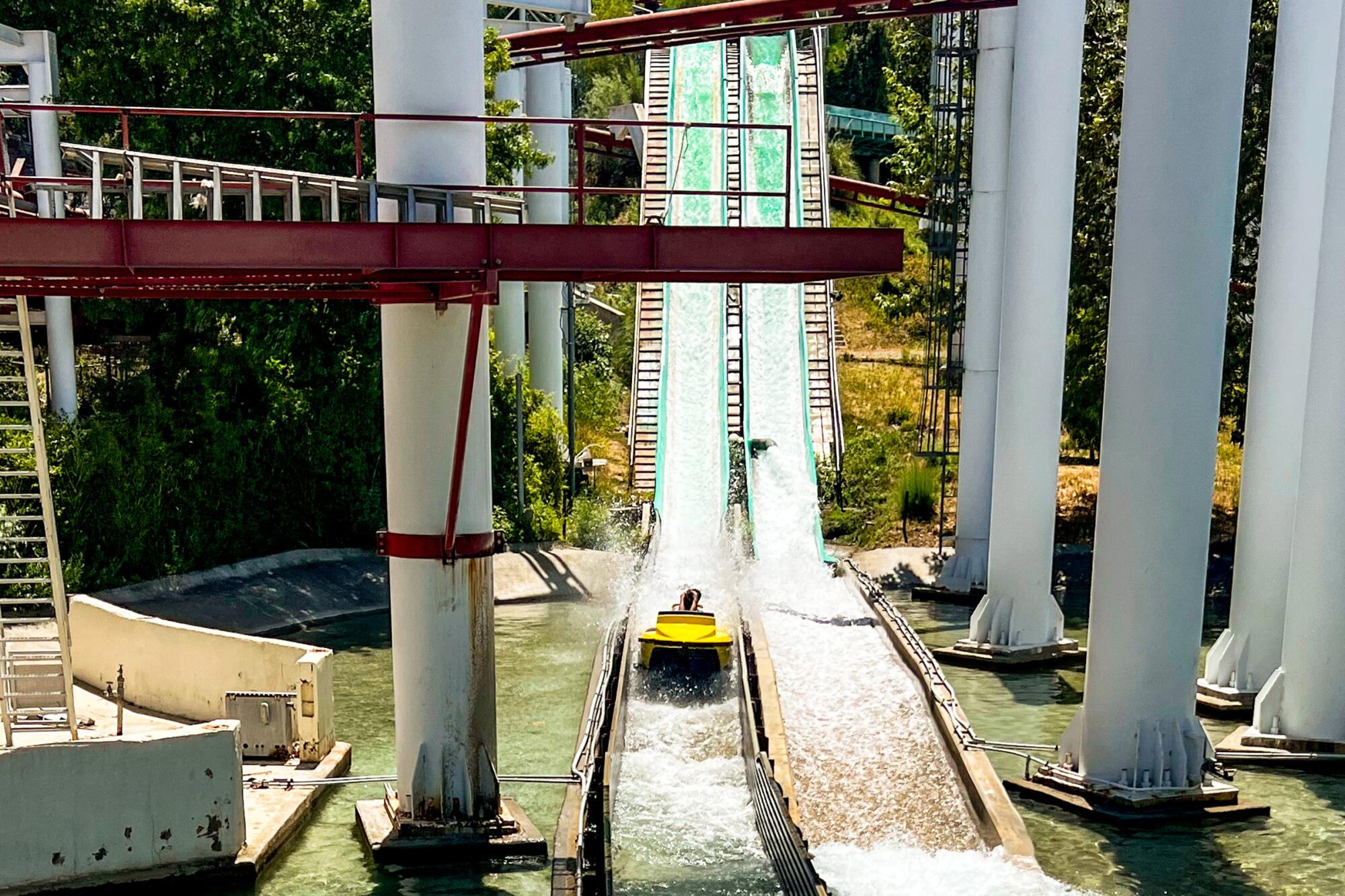
(Todd Martens / Los Angeles Times)
Jet Stream

Magic Mountain’s vintage take on a log flume attraction is no-frills — our boats go up a lift, enter a brisk current and then speed down a hill. Oddly, the back seat of the boat has a tendency to get a bit wetter than the front, perhaps because the boats have a propensity to glide when they hit the man-made pond. Still, this can be an essential ride at Magic Mountain, especially in the summer when the Valencia park is often scorching hot. Jet Stream arrived at Magic Mountain in 1972, and though it features no elaborate themes or scenery, the final splash is still an unique sensation, as the boats tend to hop and slightly accelerate upon landing.
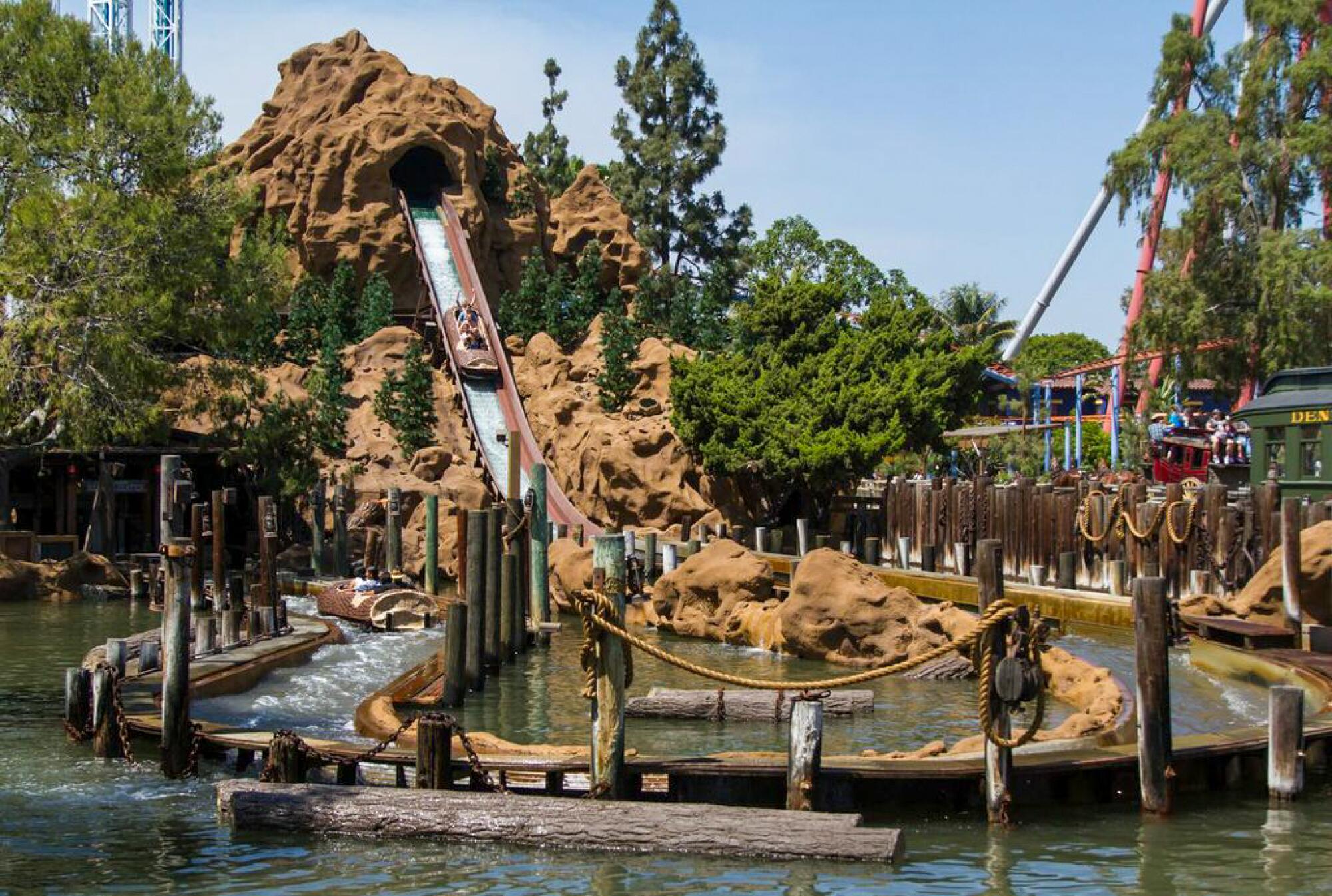
Timber Mountain Log Ride

This 1969 Knott’s Berry Farm attraction is one of the most important log fumes ever created. At the time of its opening, it was a relatively new attraction; the first proper implementation of the ride format opened in 1963 at Six Flags Over Texas. Knott’s, however, gave the ride, one that moves in its flume at a relatively brisk pace, a narrative about turn-of-the-century loggers, showing the world that thrill rides could carry a story. There are a couple of mini drops, but the grand finale is about a 40-foot decline. At times I’ve walked away relatively unscathed. Other times, I’ve been soaked from the waist down.
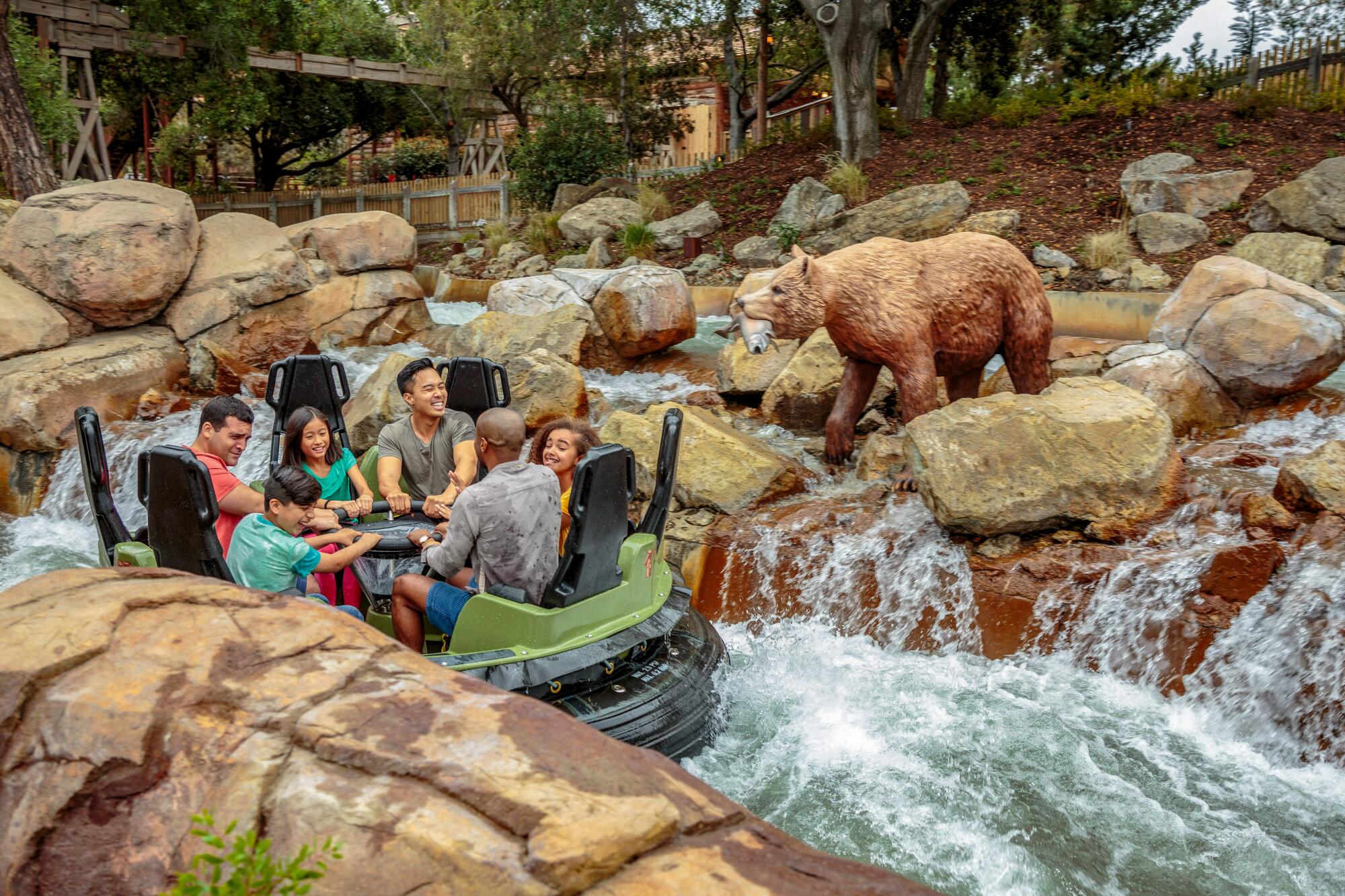
(Sean Teegarden / Knott’s Berry Farm)
Calico River Rapids

As far as river rapid rides go, I’ve never gotten drenched on this Knott’s Berry Farm attraction. Without a major drop or a rough, fast-moving current, Calico River Rapids has always been to me more about the threat of getting soaked. That’s not to say one should expect a dry experience. (Not at all. You will get wet.) Just that this rapids attraction can be conquered without a poncho. That means as we spin among its current, we can take in the vignettes that are scattered among its rocky banks. My favorite: a young bear engaged in a whack-a-mole-like game with a flock of prairie dogs. But also be on the lookout for a pesky woodpecker.
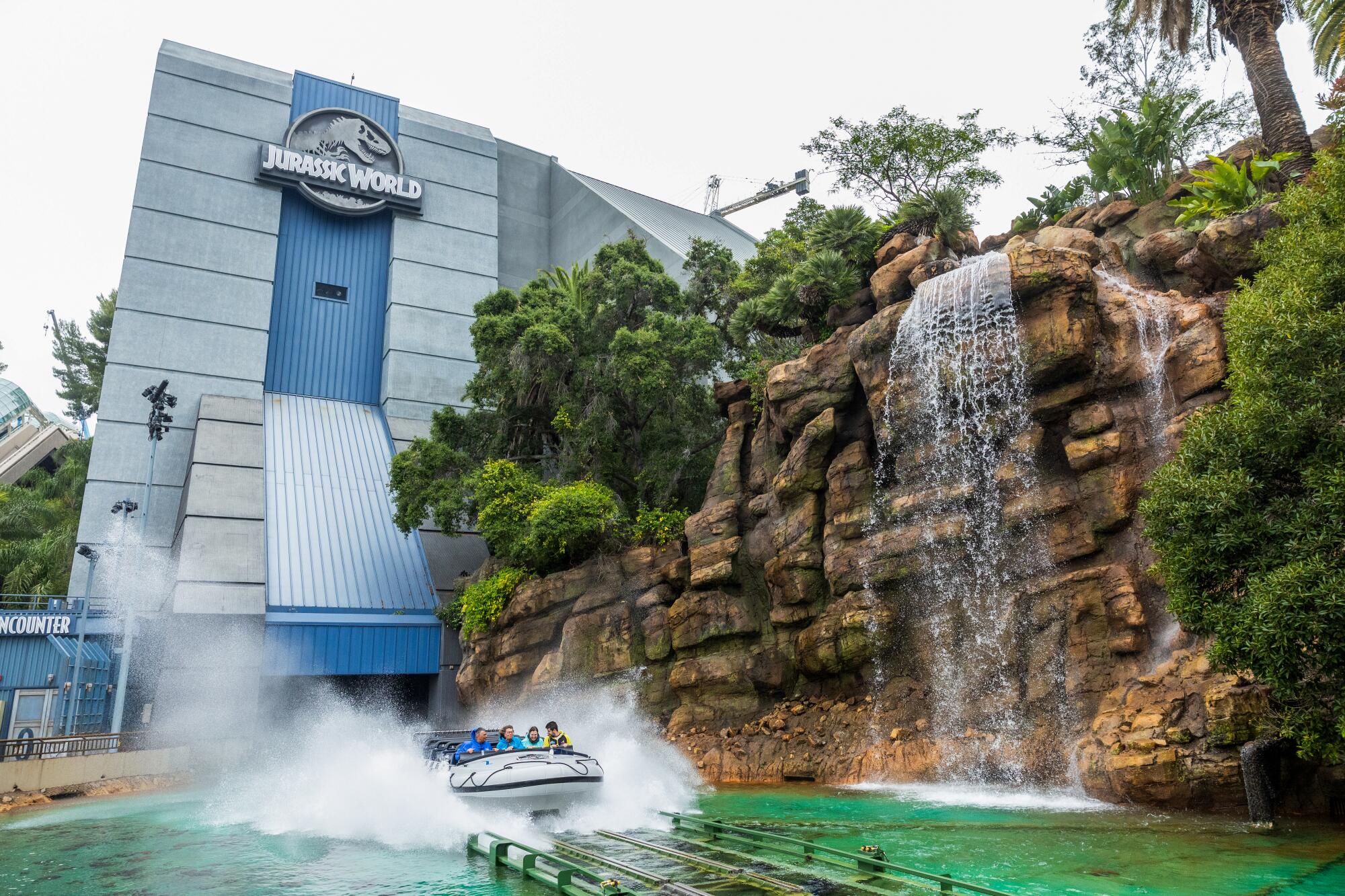
(Myung J. Chun / Los Angeles Times)
Jurassic World

Universal Studios revamped this ride in 2019 so it aligns with the most recent crop of “Jurassic World” films rather than the initial “Jurassic Park.” In doing so, designers upped its water content. We begin by gliding into a mock aquarium with a shark-eating mosasaurus looking hungrily at us tourists. Expect to be hit with water from above when the dino is shown making a leap out of the tank. But this ride is all about building tension as it leads us to an 84-foot drop. You‘ll want to linger on the top of the hill to marvel at the giant dinosaur battle with a T. Rex that unfolds there. But down you go, and when you reach the bottom it’s likely that a sizable wave will find its way onto your lap.
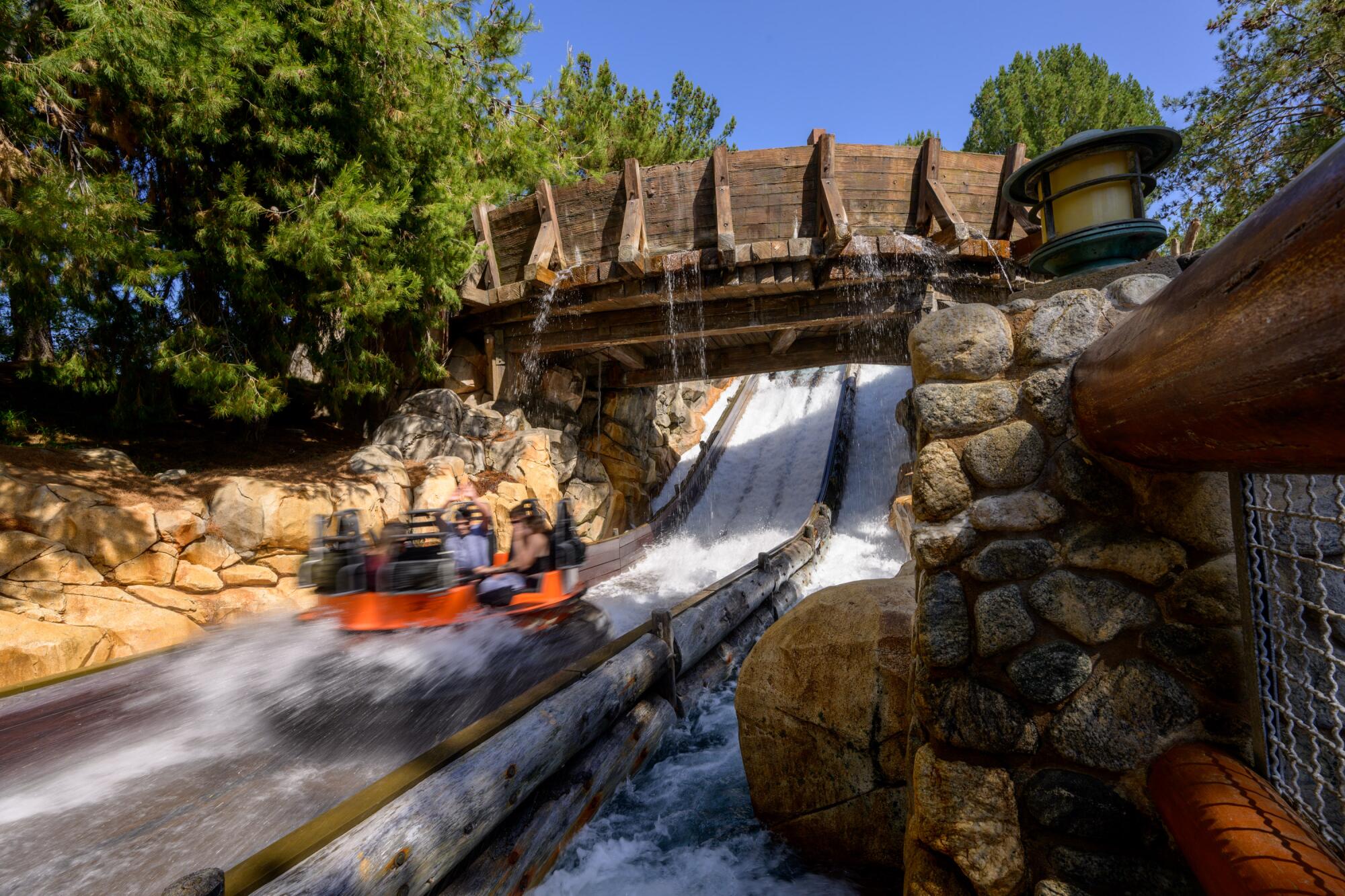
Grizzly River Run

Disney’s take on the whitewater rafting ride is robust, coming in at about seven minutes. It begins calmly, as you drift and turn around an old mining town, before the ride truly gets thrilling — and full of water. But what ultimately sets the ride apart is the overall design, which, in a relatively confined space, manages to re-create the feeling of being in a national park. The landscape is calming, but the second half of the ride is hectic, as Grizzly River Run gradually ramps up its pace and the amount of water you take on, eventually culminating with a drop that will bring even more water sloshing into the raft.
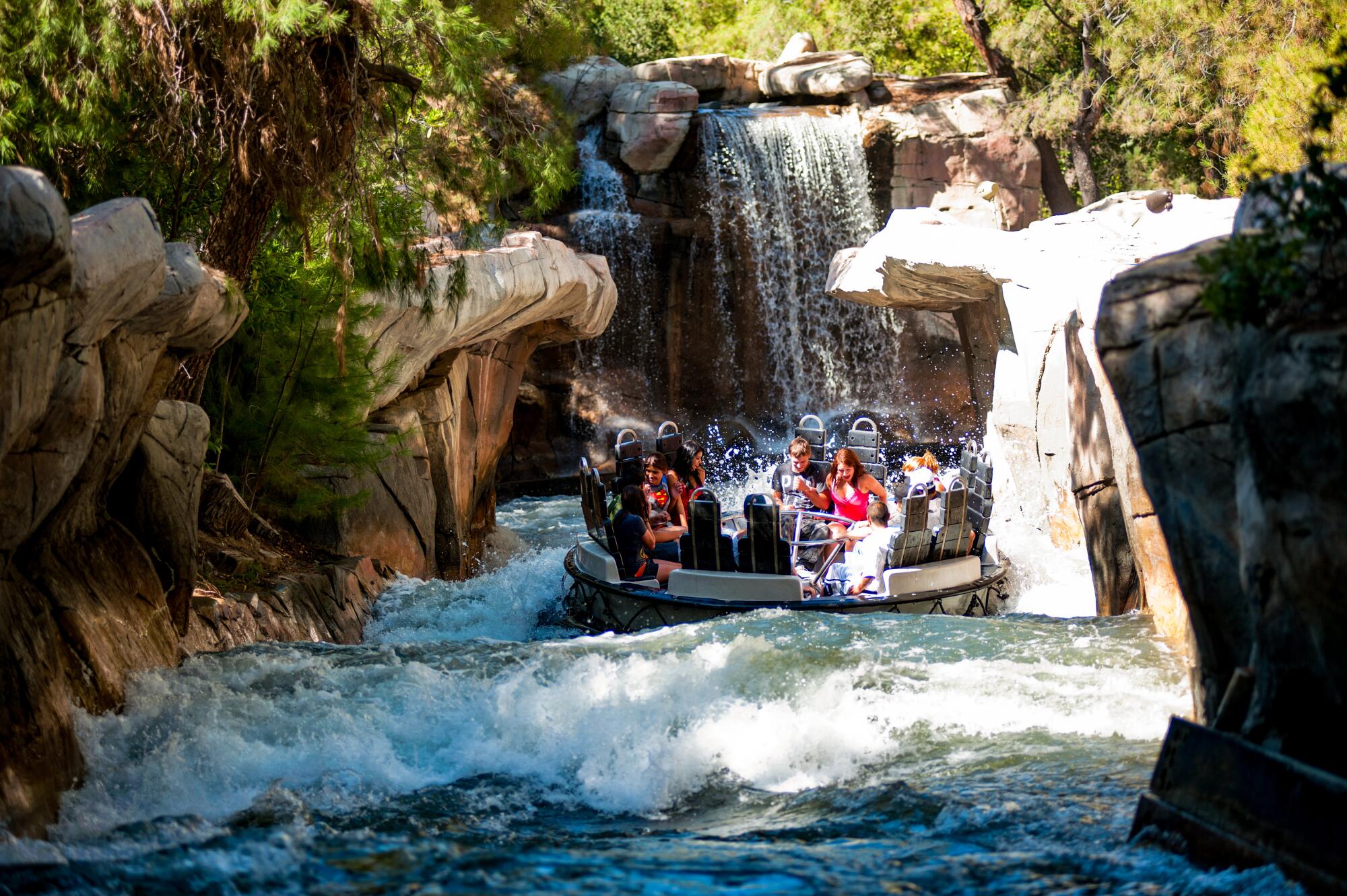
(Six Flags Magic Mountain)
Roaring Rapids

Magic Mountain’s Roaring Rapids was instrumental in the development of the whitewater rafting-type ride, as this is the first constructed in the Western U.S. But that also means it runs a little rough, which, in this case, results in riders getting absolutely drenched. As on all rapids rides, the turbulent river, buoyed by narrow chutes, moves in an unpredictable fashion. Expect about four big crushes of water to leap into the raft, and those waves will be massive — there’s no buildup, no pacing and no underlying storyline. To ride Roaring Rapids is to sign up for a soaking.

California
California warns Tesla faces 30-day sale ban for misleading use of

The California DMV on Tuesday said Tesla Motors faces a possible 30-day sale ban over its misleading use of the term “autopilot” in its marketing of electric vehicles.
On Nov. 20, an administrative judge ruled that Tesla Motors’ use of “autopilot ” and “full self-driving capability” was a misleading description of its “advanced driving assistant features,” and that it violated state law, the DMV said.
In their decision, the judge proposed suspending Tesla’s manufacturing and dealer license for 30 days. However, the DMV is giving Tesla 60 days to address its use of the term “autopilot” before temporarily suspending its dealer license.
“Tesla can take simple steps to pause this decision and permanently resolve this issue — steps autonomous vehicle companies and other automakers have been able to achieve in California’s nation-leading and supportive innovation marketplace,” DMV Director Steve Gordon said.
Tesla had already stopped its use of “full self-driving capability” and switched to “full self-driving (supervised)” after the DMV filed accusations against it in November 2023.
The DMV said its decision to file those accusations stretches back to Tesla’s 2021 marketing of its advanced driver assistance system. Besides the two terms, the DMV said it also took issue with the phrase, “The system is designed to be able to conduct short and long-distance trips with no action required by the person in the driver’s seat.”
“Vehicles equipped with those ADAS features could not at the time of those advertisements, and cannot now, operate as autonomous vehicles,” the DMV said.
As for the manufacturing license suspension, the DMV issued a permanent stay on that proposal.
California
Former California doctor sentenced in Matthew Perry’s overdose death

LOS ANGELES — A former California doctor was sentenced to 8 months of home detention and 3 years of supervised release Tuesday after pleading guilty to ketamine distribution in connection with the fatal overdose of “Friends” star Matthew Perry.
Mark Chavez pleaded guilty in 2024 to one count of conspiring to distribute ketamine to Perry, who died at 54. Chavez appeared Tuesday before U.S. District Judge Sherilyn Peace Garnett in Los Angeles. He faced up to 10 years in prison.
He will also be required to complete 300 hours of community service and pay a $100 special assessment to the U.S. government.
“My heart goes out to the Perry family,” Chavez said outside of court after his sentencing.
Zach Brooks, a member of Chavez’s legal team, said Tuesday: “what occurred in this case was a profound departure from the life he had lived up to that point. The consequences have been severe and permanent. Mr. Chavez has lost his career, his livelihood, and professional identity that he has worked for decades to develop.”
“Looking forward, Mr. Chavez understands that accountability does not end with this sentence. He’s committed to using the rest of his life to contribute positively, to support others and to ensure that nothing like this ever happens again,” Brooks said. “While he cannot undo what occurred, he can choose how he lives his life from this moment.”
Chavez was one of five people charged in connection with Perry’s death. The TV star died of an accidental overdose and was found dead in a hot tub at his Los Angeles home in October 2023.
Chavez’s lawyer, Matthew Binninger, has previously said his client was “incredibly remorseful” and “accepting responsibility” for his patient’s overdose.
Chavez was a licensed physician in San Diego who formerly operated a ketamine clinic. Prosecutors said he sold ketamine to another doctor, Salvador Plasencia, who then distributed it to Perry.
“I wonder how much this moron will pay,” Plasencia said in a text exchange to Chavez, according to the investigators. “Lets find out.”
Earlier this month, Plasencia was sentenced to two and a half years in federal prison for his involvement in the case.
Chavez wrote “a fraudulent prescription in a patient’s name without her knowledge or consent, and lied to wholesale ketamine distributors to buy additional vials of liquid ketamine that Chavez intended to sell to Plasencia for distribution to Perry,” the indictment in the case said.
In the month before his death, the doctors provided Perry with about 20 vials of ketamine and received some $55,000 in cash, according to federal prosecutors.
Perry was undergoing ketamine infusion therapy to treat depression and anxiety, according to a coroner’s report. However, the levels of ketamine in his body at the time of his death were dangerously high, roughly the same amount used for general anesthesia during surgery. The coroner ruled his death an accident.
Before his death, Perry was open about his lengthy struggles with opioid addiction and alcohol use disorder, which he chronicled in his 2022 memoir, “Friends, Lovers and the Big Terrible Thing.”
Katie Wall reported from Los Angeles and Daniella Silva reported from New York.
This is a developing story. Please check back for updates.
California
California’s first mobile 911 dispatch classroom launches in Fresno

FRESNO, Calif. (FOX26) — A mobile classroom is giving Central Valley students a hands-on look at what it takes to answer 911 calls.
The classroom on wheels is one of only two in the nation, the first in California, and is part of the Fresno Regional Occupational Program’s dispatch pathway.
“Dispatchers are the steady heartbeat of the emergency response,” Fresno County Superintendent of Schools Dr. Michele Cantwell-Copher said during Monday’s ribbon-cutting ceremony.
California’s first mobile 911 dispatch classroom launches in Fresno (Photo: FOX26 Photojournalist Byron Solorio)
Inside the trailer, students train at real dispatch consoles designed to mimic a live dispatch center.
The program is a partnership with Fresno City College, creating a pipeline from the classroom to dispatch careers.
The curriculum is backed by California POST, or the Commission on Peace Officer Standards and Training, which sets minimum training and certification standards for law enforcement in the state.
It gives students the opportunity to practice call taking and scenario based decision making in a realistic and interactive setting,
said Michelle D., with POST.
The system uses realistic audio and artificial intelligence to recreate high-pressure simulations.
“If it’s a child that is injured, we can have the child crying in the background, so it really gives them that true, realistic first-hand experience,” said Veronica Cervantes, a Supervising Communications Dispatcher with the Fresno County Sheriff’s Office.
Dispatch supervisors say programs like this one could help address a growing staffing shortage.
More people need to be in this profession. We are hurting for dispatchers
explains Matt Mendes, a Dispatch Supervisor with the Fresno County Sheriff’s Office.
Officials say the job offers competitive benefits, including a starting salary of about $53,000, overtime opportunities, and the potential to earn six figures over time.
-

 Iowa2 days ago
Iowa2 days agoAddy Brown motivated to step up in Audi Crooks’ absence vs. UNI
-

 Washington1 week ago
Washington1 week agoLIVE UPDATES: Mudslide, road closures across Western Washington
-

 Iowa1 week ago
Iowa1 week agoMatt Campbell reportedly bringing longtime Iowa State staffer to Penn State as 1st hire
-

 Iowa4 days ago
Iowa4 days agoHow much snow did Iowa get? See Iowa’s latest snowfall totals
-

 Cleveland, OH1 week ago
Cleveland, OH1 week agoMan shot, killed at downtown Cleveland nightclub: EMS
-
World1 week ago
Chiefs’ offensive line woes deepen as Wanya Morris exits with knee injury against Texans
-

 Maine22 hours ago
Maine22 hours agoElementary-aged student killed in school bus crash in southern Maine
-

 Technology6 days ago
Technology6 days agoThe Game Awards are losing their luster

















